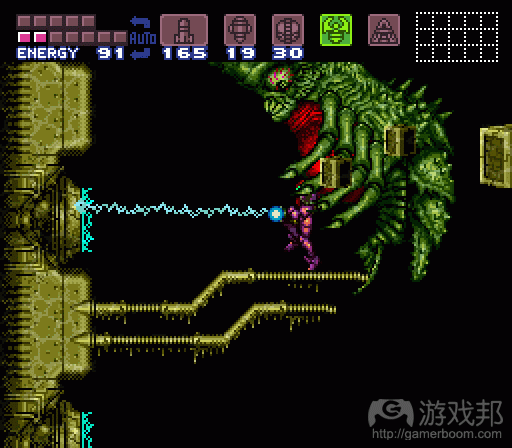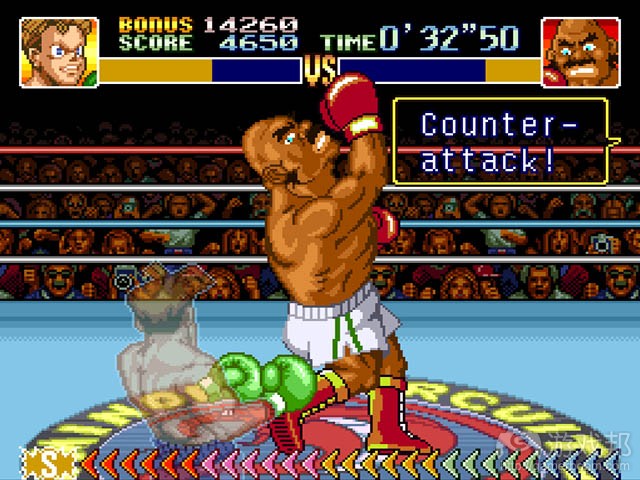开发者以经典案例谈7个典型的BOSS战役形式
本文原作者:Richard Moss
BOSS战役在电子游戏里是极其普遍的,不过很少游戏能把它做好。事实上,很多设计者在设计大事记的时候要么绊在这方面要么绊在那方面——可能把对玩家的挑战难度设过头,或者可能没能应用到玩家在战役之前学会和实践过的游戏操作。
失败的潜在因素很多,不过如果你能注意吸取至今为止的其他游戏的教训,你完全可以避免失败。为了达到这个目的,我们联系开发者询问他们有哪些最喜爱的BOOS战役是值得开发者仔细研究学习的。他们给我们答复里都倾向选择了以前的一些经典游戏,而这正证明了越新的游戏未必是越好的。以下是他们的建议。
《合金装备3》中的“The End”狙击决斗
《合金装备》系列游戏有一些令人久久难忘的BOSS战役——有初代的心理螳螂、二代的胖子还有4代的Liquid Ocelot。然而顽皮狗工作室的设计师Mattew Gallant认为在《合金装备3》中和The End的战役是这系列里的最佳战役。“那是一场在丛林中的狙击战,The End很狡猾还会伪装自己,所以玩家不得不以智取胜。”
Gallant称它是他所有遇到的对战中“操作技巧运用最多的战役”,他赞赏了这场战役中道具和操作的汇集使用的游戏导向。尤其是,玩家可以使用望远镜来找到对方的红外线瞄准器;可以用红外夜视镜来找到对方的足印;可以用定向传音器听到呼吸和低语声;可以击杀(或吃掉)The End的胡萝卜监视器,然后偷偷靠近他进行“拦截”操作——这会让他掉下特殊的伪装和一支非致死麻醉枪。
似乎这还不够,玩家还可以用一把狙击来福枪在过场动画的之后击杀The End逃避这场对战。或者,更妙的是你可以通过利用The End濒临死亡的信息来赢得胜利。“如果玩家在Boss战中保存进度,然后过了一个礼拜再载入这个存档,那他们会发现The End已经自然死亡了。”
收获:如果你的游戏有丰富的操作机制,没有什么操作是你不能放到Boss战役中的,并且如果你把这场战役做得斗智斗勇,还能有加剧局势紧张感的功效。
《超级银河战士》中与“母脑”的对决
这部经常被借鉴模仿的任天堂经典之作《超级银河战士》,包含了很多可以学习的武器种类、等级设置、难度曲线等之类的内容,但是对于《Nafarious》的创作者Josh Hano来说,这部作品里面的Boss大战是最值得学习的。他尤其指出在遇到大BOSS“母脑”的时候,画面与操作的结合最叫人欣赏。
“这么说吧,当母脑毁灭玩家操作的成熟形态的银河战士时(银河战士是从游戏开始玩家就在培养升级的),如果你有全身心投入到故事情节中的话,那你肯定超想把她干掉。而游戏创作者也懂你的心,所以他们就给了你一个可以摧毁“母脑”的新技能——,一束超激光。从游戏机制来说,这不过就是个射线而已,不过它却让你用起来感觉倍儿爽。”
收获:要让玩家情绪上憎恶游戏里的BOSS,这样他们就会在打败他们之后获得更多的成就感。
《超级银河战士》中的龙之竞技场对战
Hano还赞赏了《超级银河战士》中龙之竞技场的对战,因为这里暗藏了很多提早通关的秘密技巧。“他会移动到你附近挠你,并且在房间里飞来飞去跟你周旋。这里你可以使用你的爪钩来抓住带火花的破碎机械残骸,然后把电导向那头怪兽,这里会让玩家觉得自己智商碾压敌人,要不是发现了这个秘密方法,这关就太难过了。”
Playtonic Games主管Gavin Price对此表示赞同。他喜欢这种让玩家利用场地来对付敌人的设定,特别是在大部分情况下,“战场都是对Boss有利而且很多会有BOSS战队的小怪”,这种设定就更讨喜了。就像“母脑”之战一样,这场对决也很深地反映了游戏主旨。“这样的BOSS战役(以一种比较被动的方式)在对 ‘探索和与试验’这一游戏主旨的弘扬上找到了新方法。”
收获:要让游戏主旨和游戏机制渗透到BOSS战役里。如果你在游戏别的地方也鼓励玩家对游戏的试验探索,那就把探索的成效在boss战中回报给玩家吧。
NES游戏《忍者蛙》的The Walker——Boss的新视角
《忍者蛙》可能最出名的就是它极端磨人的难度系数,但是该游戏采用了NES的横版游戏平台可以看出这款游戏在设计思路上还是非常有野心和想法的。Price对游戏中第一关最后的BOSS战赞赏有加——他解释道:“这个Boss在关卡最后把巨大的脚才下来的时候玩家都还觉得它挺正常的,但是后来游戏画面从标准的横版视角转到了Boss视角。”
“这是一个非常新颖和有趣的视角转换,它摒弃了往常游戏所依赖的那些游戏机制和镜头视角——原来一场Boss战斗本身也可以变成一场小游戏,这打破了常规,给游戏玩法注入了新血液。”
收获:多样性是生活的调味料——一个视角或者核心游戏机制的转变完全可以燃起玩家继续游戏的激情。
《传送门》中对BOSS格拉道斯的最后战役
《传送门》整部游戏基本都在为最后大战人工智能反派BOSS——格拉多斯这场战役做铺垫。格拉多斯在游戏中反复捉弄背叛玩家,以看似无害的测试作为伪装,用蛋糕作为完成测试的奖励。玩家最后终于看到格拉多斯真面目,彼此都蓄势待发准备战斗,在一段简短的非暴力对质之后事情进入白热化阶段。这款游戏巧妙地转化了《2001》电影情节,作为游戏设计咨询师的Mike Stout(曾就职于Insomniac and Activision公司)在他的“谈2010年的boss战特点”文章中提到过——这是对传统游戏的突破。
Stout这样写道:“没有变革、没有佯装战败、这之类的都没有——格拉多斯只是捉弄玩家并调用‘死亡’这个概念【通过提及玩家早先在游戏中焚烧掉的传送门】。”这是一个激发情绪的巨大考验,这种考验一直持续到格拉多斯最后孤掷一注,想在在同归于尽之前尽全力要杀死玩家才算完结。
收获:Boss战役是游戏这个整体故事中的部分情节,因此它也要有节奏,有所预兆还要动人心弦。同样地,一些恰当好处的语言运用会比带英雄色彩的变形金刚情节带来更多的影响力和筹码。
《Super Punch-Out!!》中所有的战局
任天堂的超级拳击游戏《Super Punch-Out!!》就是一款完全的BOSS对战游戏,Price坚定认为这款游戏中的每个BOSS都值得开发者去仔细研习的。他说:“在玩家所能进行的操作不多的情况下,《Super Punch-Out》成功地找到了16种方法来独立出色地检测玩家的拳击能力,这相比其他游戏出色太多了。”
人物动画的秘密。Price解释说明道:“每个人物的动画速度和一连串动作都有明显的区别,而且游戏对每个人物的动作设计能够让玩家能够在视觉上找到信息来战胜这个挑战。”细看对手的动作顺序,你会找到预示下一个动作的线索,这时对手的攻击方式和弱点就一清二楚了,你也就可以根据这点来制定应对策略了。Price表明,这是非常重要的学习内容,因为《Super Punch-Out》让我们知道,只要方法得当,即使是每一场单独的战斗机制都是可以变得有挑战力、有带入感的。况且,有了这种视觉信息,设计者就能够避免玩家在游戏中不必要的困惑和沮丧。
收获:你所需要的就是要有一个被良好执行、精心调校的游戏机制,但对于具备清晰的视觉反馈来展示玩家动作效果、提示boss弱点所在位置也是至关重要的。
《Undertale》中想象力丰富、角色丰满、推动情节发展的BOSS之战
《Torment: Tides of Numenera》场景首席设计师George Ziets点名独立RPG游戏《Undertale》是他最喜欢的BOSS战例这几。他相信战斗的(连同游戏中的其他部分)设置就是为了让故事能够展开,让玩家能够做出选择而改变不同角色的结局。Ziets说《Undertale》是在这方面做得尤其出色的游戏。他这样解释:“游戏很好地塑造了角色隐藏在外表行为(通常都是幽默式的)下的真实动机,从而创造了人物的多面性,这些更深层的人物特点会随着一系列连续的战斗被更多地挖掘出来。”
更多地从游戏机制方面来说,这个游戏的BOSS战役是属于解谜类的,所以答案从来都不止一种,并且这些答案都通常都要结合人物对话、物品以及向敌人展示怜悯的机会来给出。“要如何解决他们完全取决于玩家的选择,”他这样解释,“而那种最直接把敌人杀死的方法绝对不是我们想要的结果。”
Ziet表示,基本每个《UNDERTALE》的BOSS战役都是值得游戏设计者研习的,因为它充满想象力的多种游戏机制、用幽默将boss们塑造得楚楚可怜。他特别指出了几个例子:在一场对Royal Guards的战斗中,“为装甲清洁”的这个选择就显示了他们之间没有回应的浪漫情感,并且将战斗引向了一个无暴力的美好结局;相反地,如果选择了“很抱歉”,那伪装的角色就会以战斗的形式进行交互。游戏中其他的战斗也都体现了人物的个性与特点——“在碰到Metaton和Alphys的时候,玩家可以明显感受到她对Undyne的爱情和对有危险行为的机器人Metaton的那种柔情。”
收获:BOSS战役表现了人物之间的矛盾,这种矛盾——如果可以通过关系的发展或者怜悯之情或者更多的情节推动——也许并非一定要通过暴力的方式来解决。
冲突与挑战
归根结底,boss战役是用来检测玩家游戏技能掌握,奖励玩家的进步以及推动故事情节的。最好的范例就是谁能在不忽视或不过度困扰玩家的情况下赋予游戏全新的面貌——你不是单纯地为了揍一个大反派而战斗的。
要主动考虑到玩家和他们的期望,以新方式展现出冲突和特色,但是记住要保持主题和游戏机制的一致性——否则你会造成流失玩家的风险——因为他们再也不想再忍受这些boss战役和游戏其他部分在系统、概念和主题上的根本性脱节。
本文由游戏邦编译,转载请注明来源,或咨询微信zhengjintiao
They’re extremely common in video games, but boss fights are hard to do well. Indeed, many designers stumble on one aspect or another when crafting their big encounters — perhaps leaning too hard on the need to challenge the player, or maybe failing to incorporate (and subtly tweak) the mechanics learned and practiced in the lead up to that fight.
There are many potential points of failure, but you can avoid them all if you take heed of the lessons presented by other games past and present. To that end, we reached out to developers to ask for their favorite examples of great boss fights that are worthy of close study. Those who responded tended to favor the classics of yesteryear, in testament to the fact that newer is not always better. Here are their suggestions.
‘The End’ sniper duel from Metal Gear Solid 3
The Metal Gear Solid games have long had memorable boss fights — be it Psycho Mantis in the first game, Fat Man from MGS2, or Liquid Ocelot in Guns of the Patriots. But Naughty Dog designer Matthew Gallant thinks The End from Metal Gear Solid 3 is the best of the bunch. “It’s a sniper duel in a huge jungle arena,” he explains. “The End is sneaky and camouflaged, forcing the player to outwit him. The fight creates a very palpable sense of being hunted.”
Gallant calls it “the most mechanically-rich boss fight” he’s ever encountered, praising the assemblage of tools and mechanics it draws upon. In particular, the player can use binoculars to search for the glint off his sniper scope, find footprint trails with thermal goggles, use a directional microphone to listen for breathing or muttering, kill (and eat!) The End’s spotter parrot, and sneak up on him to use the game’s “hold up” maneuver — which causes him to drop a special camouflage and non-lethal tranquilizer gun.
And as if that’s not enough, the player can avoid the fight altogether by shooting The End with a sniper rifle after an early-game cutscene. Or, even more cleverly, it’s possible to play on the information that The End is close to death. “If the player saves during the boss fight and loads their save more than a week later,” explains Gallant, “then they find that The End has died of natural causes.”
Takeaway: If your game has a rich set of mechanics, there’s nothing to say you can’t incorporate them all into a boss fight, and it can heighten the tension if you make it as much a battle of wits as of brawn.
Super Metroid’s Mother Brain
The oft-imitated SNES classic Super Metroid bears all sorts of design lessons in weapons, levels, difficulty curves, and more, but for Nefarious creator Josh Hano it’s especially worthy of study for its boss fights. He points to the Mother Brain encounter, in particular, for its use of aesthetic and mechanical cohesion.
“Namely, when Brain destroys the now grown-up metroid you ‘adopted’ in the opening cut scene,” explains Hano. “If you’re at all invested in the story you want to absolutely trash her for it. The game creators knew this, and so they gave you the ultra laser, a new ability that can absolutely wreck Mother Brain. Mechanically it’s a simple point and shoot laser, but it feels completely satisfying to use.”
Takeaway: Give the player an emotional reason to hate your boss and they’ll find it all-the-more rewarding to take them down.
Super Metroid’s Draygon arena fight
Hano also praised Super Metroid’s Draygon fight for its inclusion of a secret trick to end the fight early. “He has a move where he grabs you, and flies around the room with you,” says Hano. “You may use your grappling hook to grab onto a sparking bit of broken machinery and channel electricity into the beast. Which really felt like you were outsmarting a much tougher opponent because if you don’t use that secret, he is a very difficult fight.”
Playtonic Games director and Rare alum Gavin Price agrees. He loves that it allowed the player to turn the arena against the boss, especially since “arenas usually always favor the boss and load the odds in their favor.” Like the Mother Brain fight, this also tied into a deeper theme. “The boss fight found a way to still encourage the game’s core (and more passive) theme of experimentation and exploration amidst a mechanically-challenging fracas,” says Price.
Takeaway: Keep your boss fight designs consistent with the game’s underlying themes as well as its mechanics. And if you’ve encouraged experimentation elsewhere, reward it here.
The Walker boss’ new point of view in NES Battletoads
Battletoads may be best known for its extreme, ultra-punishing difficulty, but the NES side-scrolling beat-’em-up was also filled with ambitious and clever design ideas. Price speaks highly of the boss fight at the end of the first level. “This boss looked to be the normal affair with a brief glimpse of it at the end of the level as a huge leg plunged down,” he explains. But then the game switched things up and changed from the standard side-scrolling viewpoint to the boss’ point of view.
“With a very novel and fun twist that shows that regardless of mechanics and cameras the game usually relies on,” says Price, “a boss can be its own mini-game like experience and break up the regular gameplay with a fresh take on things.”
Takeaway: Variety is the spice of life — a change in perspective or a new twist on a core mechanic could be just the spark to get the player excited about tackling the next stage of the game.
Portal’s final assault on GLadOS
Portal spends the entire game building up to a big fight against its malevolent AI antagonist GLadOS. GLadOS taunts and teases and betrays the player repeatedly under the guise of innocent tests that’ll be rewarded upon completion with cake. When the player finally reaches GLadOS, they’re primed for battle, and after a brief non-violent confrontation things quickly escalate. The game then cleverly channels the film 2001 and, as game design consultant Mike Stout (formerly of Insomniac and Activision) noted in his 2010 feature on boss battle design, it breaks from convention.
“Instead of a transformation, a false defeat, or anything like that — GLadOS simply taunts the player and invokes the idea of ‘death’ [by referring to the companion cube the player incinerated early in the game],” Stout wrote. It’s an emotional priming for the big test, as GLadOS goes all-out to kill the player, ahead of an even bigger final payoff — explosions, fireworks, and a song (but no cake).
Takeaway: A boss fight is a story within the larger story of the game, and as such it should have beats that build anticipation and charge emotions. Also, a few well-placed words can have more impact and raise the stakes further than a larger-than-life physical transformation.
The fights in Super Punch-Out!! All of them.
Super Nintendo boxing game Super Punch-Out is nothing but boss fights, but Price believes each and every one of them is worthy of close study. “Super Punch-Out manages to find 16 unique and brilliant ways to test the players pugilistic powers based on very few actual moves available to the player,” says Price. “Many games struggle to do this once.”
The secret is in the character animations. “Each animation’s speed and sequence of events are distinct and very well thought out to be able to equip the player with all the visual information they need to overcome the challenge,” explains Price. Watch opponents’ animations closely and you’ll get clues to help you predict when, where, and how they’ll attack or become vulnerable, and you can devise strategies accordingly. It’s an important lesson, Price argues, as Super Punch-Out shows that even a single battle mechanic can be challenging and engaging if executed well. Moreover, by providing this kind of visual information, the designers managed to avoid unnecessary player confusion and frustration.
Takeaway: One well-executed, carefully-tuned mechanic is all you need, but either way it’s vital to have clear visual feedback that not only shows the effects of a player’s actions but also provides clues as to where the boss’ weakness lies.
Undertale’s imaginative, character-laden, story-developing boss fights
Torment: Tides of Numenera lead area designer George Ziets points to indie RPG Undertale as his favorite example of great boss fight design. He believes that combat (along with every other part of a game) is an opportunity to reveal story and to offer the player options that would change outcomes with characters. Ziets says that Undertale does this especially well. “The game was great at creating layered characters with hidden motivations beneath their (often humorous) outward behavior, and the deeper characterization was almost always revealed during the combat sequences,” he explains.
More mechanically speaking, its boss fights are puzzles, always with more than one solution, and usually incorporating dialogue, items, and the opportunity to show enemies mercy. “It is up to the player to discover how best to resolve them,” he explains. “And the most obvious approach of killing your enemies is never the ideal result.”
Ziets suggests that nearly every Undertale boss fight is worthy of study, for the imaginative variation in mechanics and use of humor to make bosses more sympathetic characters. But he picked a few examples to highlight: in one battle, against the Royal Guards, selecting the “clean armor” option reveals unrequited romantic feelings between them and unlocks a non-violent, happy ending to the fight; the “So Sorry” encounter, by contrast, disguised character interactions in the form of fights. Other battles revealed character and personality. “In the encounters with Metaton and Alphys,” says Ziets, “the player could learn about Alphys’ crush on Undyne and her tender feelings toward her robotic creation, Metaton, despite his dangerous behavior.”
Takeaway: Boss fights present conflict between characters, and that conflict need not necessarily be violent if it’s about developing relationships or empathy or furthering a story beat.
Conflict and challenge
When it comes down to it, boss fights are about testing mastery, rewarding progress, and furthering the story. The best examples put a fresh spin on a game without alienating or unduly confusing the player, and they come with clear motivations — you don’t just fight a big baddie because they’re there.
Be willing to play with your player and their expectations, to present conflict and characters in a new light, but remember they still need to be consistent both thematically and mechanically — otherwise you risk losing the players who can’t or won’t put up with any radical departures from the systems, ideas, and motifs you’ve spent the rest of the game establishing. (source:gamasutra.com )













































